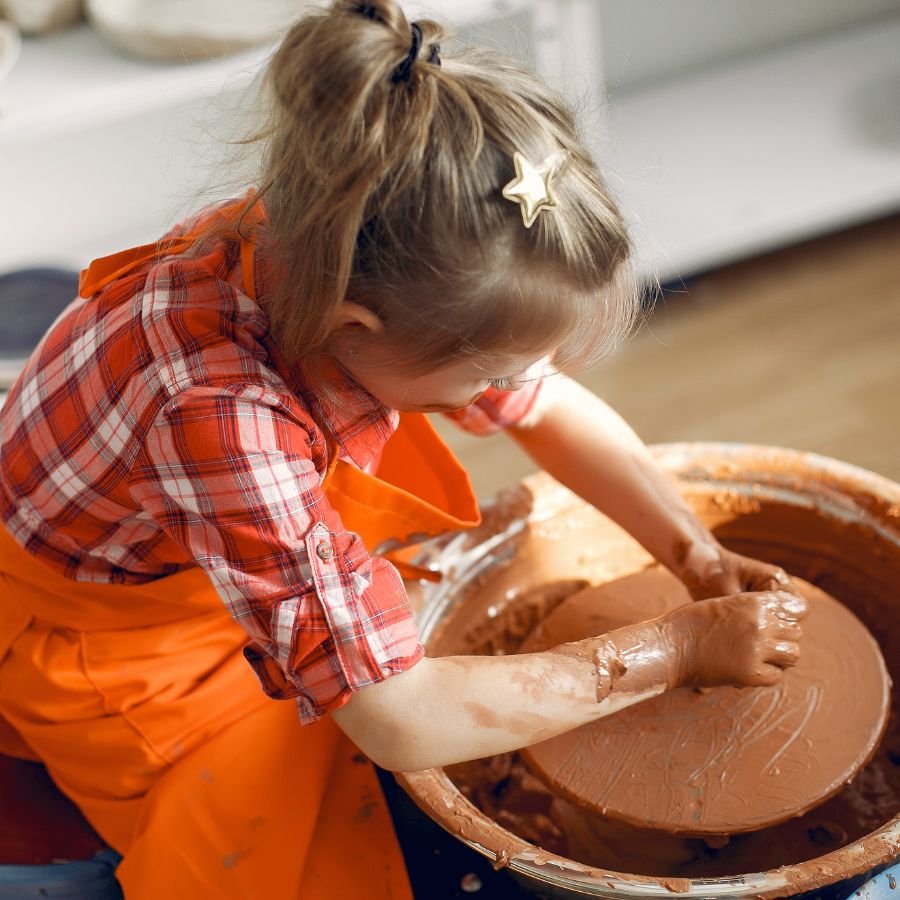Pottery is one of the most engaging, sensory-rich and creativity-boosting activities children can participate in. It allows kids to explore textures, shapes, and artistic freedom in a hands-on, relaxing environment. But one question parents and educators frequently ask is: How long should a pottery session for kids actually last?
The right duration is essential—too short, and kids may not complete their project; too long, and they may lose interest or become overwhelmed. This article breaks down the ideal pottery session length by age group, explores the factors that influence duration, and provides expert insights to help you plan the perfect class.
Why Does the Duration of a Kids’ Pottery Session Matter?
1. Maintaining Engagement
Children’s attention spans vary widely depending on age, energy levels, and prior exposure to hands-on activities. A session that extends beyond what a child can handle may lead to restlessness or frustration. On the other hand, a well-timed session helps keep the child curious, engaged, and enthusiastic.
2. Enhancing Learning Outcomes
Pottery involves multiple steps—demonstration, shaping, decorating, and sometimes glazing. Kids need enough time to absorb instructions, explore techniques, and enjoy the creative process without feeling rushed. A balanced session ensures both fun and learning.
3. Ensuring Safety and Focus
Clay tools, spinning wheels, and materials require attention and supervision. When children get tired, they’re more likely to mishandle tools or rush their work. A session that’s too long may inadvertently compromise safety.
Ideal Pottery Session Duration by Age Group
Children of different ages have different levels of focus, attention span, and motor skills. Here’s a detailed guideline based on child development and pottery instructors’ recommendations:
Ages 3–5 (Preschoolers)
Recommended Duration: 20–30 minutes
Young children in this age bracket are curious, energetic, and easily distracted. Short and simple pottery for kids activities work best, allowing them to experiment with shapes and textures. Activities should be tactile and fun—pinch pots, rolling clay, or creating basic shapes.
Why this duration works:
-
Preschoolers fatigue quickly with structured tasks
-
Short sessions prevent meltdowns or boredom
-
Ideal for introducing clay and sensory play
Ages 6–8 (Early Primary School)
Recommended Duration: 30–45 minutes
Kids in this range have better fine motor coordination and can follow multi-step instructions. They enjoy more structured projects such as coil pots, simple figurines, stamping, or basic sculpting.
Why this duration works:
-
They can stay engaged longer
-
More capable of following instructions
-
Still benefit from activities that mix guidance with freedom
Ages 9–12 (Pre-teens)
Recommended Duration: 45–60 minutes
This age group is capable of deeper concentration, more detailed work, and even beginning wheel throwing (with supervision). They enjoy the challenge of creating functional or decorative pieces.
Why this duration works:
-
Higher patience and creativity
-
Interest in challenging projects
-
Ability to handle tools with better control
Teenagers
Recommended Duration: 60–90 minutes
Teens can manage complex pottery techniques including wheel throwing, sculpting, glazing, and multi-stage projects. They are typically eager to invest more time into artistic expression.
Why this duration works:
-
Advanced skill-building
-
Greater focus and endurance
-
Ability to work independently with occasional guidance
Key Factors That Influence Pottery Session Length
While age is important, several other factors can affect how long a session should last:
1. Type of Pottery Project
Simple hand-building activities require less time. More advanced techniques such as wheel throwing, sculpting, or multi-step creations require extended sessions.
2. Class Format
-
One-time workshops may be shorter to accommodate new learners.
-
Ongoing classes allow for longer sessions to cover new techniques each week.
3. Group Size
Larger groups mean more time spent assisting individual kids, which can naturally extend the duration of the session.
4. Skill Level
Beginners generally require more demonstrations and help. Kids with prior experience may work faster and more independently.
5. Materials Used
Air-dry clay dries quickly and works well for shorter sessions. Pottery clay requiring kiln firing tends to involve detailed work that benefits from longer classes.
Sample 45-Minute Pottery Session for Kids
If you’re structuring a standard session, particularly for ages 6–10, a 45-minute plan works wonderfully. Here’s a simple layout:
-
5 minutes – Introduction & safety rules
-
10 minutes – Demonstration of technique
-
20 minutes – Hands-on clay sculpting
-
5 minutes – Decorating or adding final touches
-
5 minutes – Clean-up and display
This structure gives children time to learn, create, and wrap up comfortably.
Signs a Pottery Session Is Too Long (or Too Short)
Your session may be too long if:
-
Kids become restless or distracted
-
Mistakes increase due to fatigue
-
They rush the final steps
-
They ask to stop earlier
Your session may be too short if:
-
Kids can’t complete their project
-
The activity feels rushed
-
They want more time to decorate or refine
-
Creativity feels limited
A well-timed session maintains excitement and ensures each child feels proud of their finished piece.
Expert Tips for Planning the Perfect Pottery Session
Pottery instructors often recommend:
-
Choose age-appropriate projects
-
Break longer sessions into smaller segments
-
Give short breaks for younger children
-
Encourage open-ended creativity
-
Provide simple, clear instructions
-
Keep materials non-toxic and child-friendly
-
Display children’s finished work to boost confidence
These small touches make a big difference in how enjoyable and productive the session becomes.
Tips for Parents and Teachers Choosing a Pottery Class for Kids
-
Confirm the class is designed specifically for your child’s age group
-
Ask about teacher-to-student ratio
-
Check whether the studio uses child-safe clay and tools
-
Inquire about kiln-firing timelines
-
Ask whether parents can stay for the session
-
Look for trial classes to assess fit
The best studio is one that balances creativity, structure, and safety.
Conclusion
So, how long should a pottery session for kids typically last? The ideal duration depends largely on age, skill level, and the type of project. Generally, 20–90 minutes is the recommended range, with younger children needing shorter sessions and older kids thriving during longer, more detailed classes.
Choosing the right class duration ensures children stay excited, focused, and inspired—making pottery not just an art activity, but a memorable creative experience.
Frequently Asked Questions (FAQs)
1. What is the minimum age for kids to start pottery?
Most studios welcome children as young as 3, offering simple clay play sessions to introduce basic sensory experiences.
2. Can young children use a pottery wheel?
It’s usually recommended for ages 9 and above under careful supervision due to the coordination required.
3. Should parents stay during the pottery session?
For kids under 6, it’s often encouraged. Older children may participate independently depending on studio policy.
4. Is pottery messy for kids?
Yes, but in a fun way! Clay can be messy, but studios provide aprons and easy-clean materials.
5. How long does pottery take to dry or fire?
-
Air-dry clay: 24–72 hours
-
Kiln-fired clay: 1–2 weeks depending on the studio’s schedule
6. Are shorter sessions still effective?
Absolutely. Short but consistent sessions are great for building fine motor skills, confidence, and creativity.
7. Do pottery studios offer trial classes?
Many do, typically lasting 30–45 minutes to give kids a feel for working with clay.



Leave a Reply